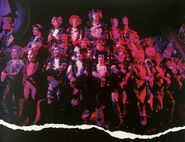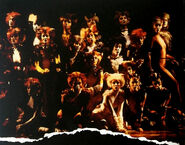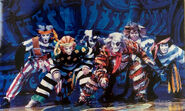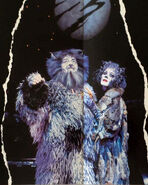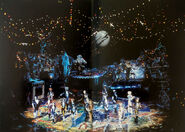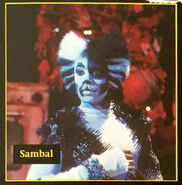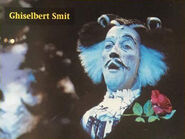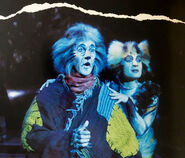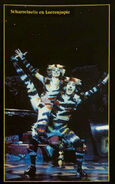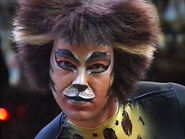Cats had its Belgian premiere in Antwerp on May 31, 1996 at the Stadsschouwburg Antwerpen. The production ran until 22nd September 1996.
Production Specifics[]
The show was based on the London Production and the 2nd UK Tour. The whole score, staging, orchestration and the costume design were based on the early London production. This meant Mistoffelees sang "The Old Gumbie Cat" instead of Munkustrap and the spoken lines ("Matinee lines") that were featured in London were also used. The cast consisted of 22 cats, with Electra but no Bill Bailey.
The songs were sung in Flemish with altered lyrics based on the Dutch translation by Gerrit Komrij used in the Amsterdam production. The alterations were made by Paul Berkenman. The production used the NAP 15 set, which was later transferred to Germany.
This production also featured Veerle Casteleyn as Sillabub, called Sylvani, who would later go on to be cast in the same role in other productions, including the London production and 1998 film. Other actors like Marco Vermie and Matthew Jessner could already be seen in the Euro Tour; Matthew Jessner also in the Vienna and Paris productions. Agnes Vandrepote went on to join the London and UK Tour casts, and similarly Oliver Tóth went on to be in the Australian Tent Tour production; Tim van der Straeten played Mistoffelees and Pouncival in Hamburg, Stuttgart and Copenhagen, Marco Krämer played Skimbleshanks in Hamburg. Roberto de Groot, Veerle Casteleyn and Suzanne Heyne later reprised their roles on the 2006 Dutch Tour.
Notably, this was Marco Vermie's final production, as he died a few days after the opening performance. He was replaced by Rob van der Meule for the remainder of the production's run.

Press Reel - Antwerp 1996
Cast[]
This production followed the 1993 UK Tour in including Electra instead of Bill Bailey/Tumblebrutus, but the kitten track was also covered by male swings, naming the character "Tombrutus" when the role was performed by a male cover.
Gallery[]
Media[]
Reviews[]
Review #1 by Henk van Gelder (translated from Dutch):[1]
Three times the Dutch-language version of the musical Cats was shown for months at the Carré theater in Amsterdam, in 1987, 1988 and 1993 - and apparently the demand was still not satisfactorily met. Since it was announced that the musical department of the Royal Ballet of Flanders would study the success show for a summer series at the Stadsschouwburg in Antwerp, Dutch bus companies have also set course again for the song and dance festival set to the cat verses of TS Eliot translated by Gerrit Komrij. The colossal Antwerp theater has one disadvantage compared to Carré: the production cannot be played in-the-round. Although the quaint garbage dump that forms the backdrop is on the opposite side of the hall, and the garlands of colored lights also hang above the audience, the action is largely limited to the stage in the frame. But on Friday evening, when the show premiered in the presence of Belgian Prime Minister Dehaene, I did not have the impression that it was less fun. On the contrary: the Royal Ballet of Flanders, which so far has exclusively produced travel shows, has achieved a well-deserved success with its first production in one place.
More than a musical, Cats is a series of colorful song numbers to catchy music by Andrew Lloyd Webber, in which each of the cattypes invented by Eliot is presented. There is hardly any intrigue, and that is probably why the low intelligibility rarely forms a stumbling block. Eliot simply wrote verses full of clauses and enjambements that are difficult to sing in a tight rock rhythm. Only in a few soli can it be heard that Komrij's translation has "faded", so that, for example, the slobbering Ghiselbert Smit has been transferred from The Hague area of Pulchri and De Witte to an environment of Antwerp chic. He is sung with verve by the Dutch Cats routinier Marco Vermie, who is also the theater cat - now no longer yearning for Van Dalsum, but for the glory days of the Flemish People's Theater.
In the ten years of its existence, the Royal Ballet of Flanders has often paid tribute to charming, sometimes even heart-catching performances of existing musicals, whose simplicity often attracted. However, if you want to play a show like Cats, you are contractually obliged to make a clone of the original London production under the supervision of a director and choreographer designated by the original producer. Within this artistic straitjacket, this staging is at least an adequate copy and occasionally - through the input of some formidable dancers and expressive vocalists - more than that. Cats is back, and more than half of the tickets have already been sold.
Review #2 by Patrick van den Hanenberg (translated from Dutch):[2]
The most famous eyes in the world do not belong to a movie star, hypnotist or dictator, but to a cat. The cat of the promotional image of the musical Cats. Two yellow spots on a pitch black surface, and in those spots two vague dancing figures can be recognized.
Everyone who walks through Antwerp is touched by those eyes and enticed to the Stadsschouwburg. There, the cats crawl over the garbage dump until the end of July, the well-known backdrop of Cats. And preferably all summer. Only then is the Cats mission of the Royal Ballet of Flanders (KBV) and Joop van den Ende, who have found each other for this production, really successful.
The purpose of the series is clear. Just as Cats had to boost the dug-in musical company in the Netherlands in 1987, the same show now has to push the Flemish people definitively into the musical camp. The musical department of the KBV has every interest in that. Because this fall, the company will be releasing its own musical about Sacco and Vanzetti on the occasion of the tenth anniversary, two Italian emigrants who were put on dubious grounds in the US in the xenophobic 1920s.
Such a political and therefore risky production can only succeed if the musical atmosphere is good, and people are not there yet in Flanders. Joop van den Ende can make good use of the six million Flemish expansion of territory for his valuable travel ideas. The cats again as crowbar.
Cats is a musical that can hardly be honored artistically. Someone is sent from the Andrew Lloyd Webber headquarters who ensures that people do not break the prescribed straitjacket of the parent production. And furthermore it is a fill exercise, the right artist in the right catkin.
Yet that has been pretty difficult, because the all-rounders that Cats needs are hard to find. Most KBV players come from the dance corner. The former top gymnast Elvira Becks shows spectacular acrobatics. Cats-Antwerp consists of smoothly moving cats with too many fragile voices. Even Frank Hoelen, who previously played the macho Tuk Stuk Rukker in Amsterdam, seems to be holding back. He does not sing greasy and gross enough for his role. A few others, however, such as An Lauwereins and Hilde Norga, could come along in every international top performance.
On the annual Jubikel Ball, the old wise male Uncle Deuteromium points to a cat who can start a new life in the Ionosphere. Koos de Theaterkat, Van Zonderen de Wonderkat and ten more are in the spotlight, but Grisabella, who is haughtily ignored by the other cats, has won prizes.
In his cat poems, on which Cats is based, TS Eliot had reserved only eight lines for the expired glamor cat Grisabella. In the musical she is actually the most clearly elaborated character. "She was hanging and sharing in night cafes." Slightly too showy, a little too much glitter. At the end of her life she makes a sad impression.
Even though she is only in the picture a few times, a Cats show can be totally ruined by a weak Grisabella. Hilde Norga has the right attitude for the burned-out cat, who is ashamed of her situation, and sings the famous Memory so beautifully that all other weaker singing performances are compensated in one fell swoop.
The Antwerp Cats is a solid show, with technology and music as a solid foundation. It is a story of nothing and therefore the musical for all ages. The performance still stands as a musical picture book. Even though the choreography could use some refreshment and a few denominations can give the show the actual pace of this time.
References[]
- ↑ Nederland kan nu naar vervlaamste Cats in Antwerpen, NRC Handelsblad, 3 June 1996
- ↑ Cats moet Vlaamse musical wakker schudden, de Volkskrant, 5 June 1996


